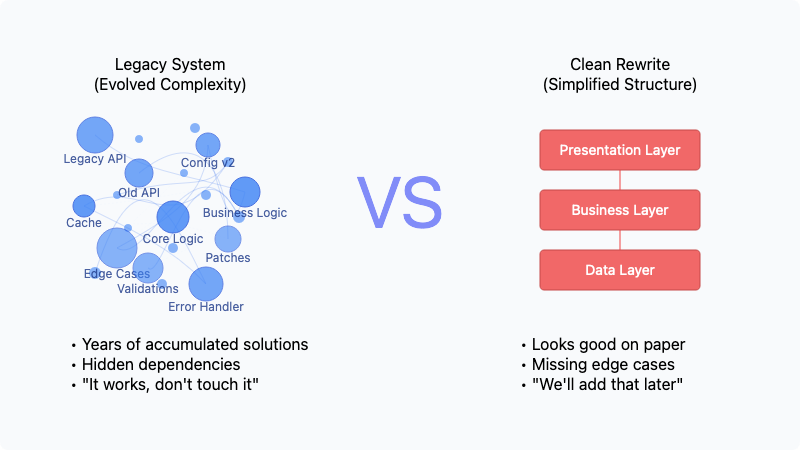They paved paradise to put up a parking lot

In the aftermath of that catastrophe, researchers made a striking discovery: in Indonesia’s Aceh province, villages protected by dense mangrove forests experienced dramatically lower death tolls compared to exposed coastal areas.
Nature had already engineered an elegant solution to coastal protection. Mangrove forests, with their complex root systems and dense vegetation, act as natural barriers against storm surges and tsunamis. They’re not just walls of trees - they’re intricate ecosystems that have evolved over millions of years to protect coastlines.
Yet, in our pursuit of “development,” we’ve systematically destroyed these natural safeguards. Mangrove forests have been cleared for shrimp farms, tourist resorts, and urban expansion. We replaced nature’s sophisticated defense system with simplified human-made structures - seawalls, breakwaters, and parking lots.
This pattern repeats itself across the globe: we destroy complex natural systems and replace them with simplified artificial ones, often with devastating consequences:
Urban planners raze diverse neighborhoods that developed their own organic social fabric and support systems, replacing them with sterile planned communities that look better on paper but lack the complex web of relationships that made the original neighborhoods resilient.
Modern agriculture replaces biodiverse traditional farming with vast monoculture fields. While more “efficient” on paper, these simplified systems are far more vulnerable to pests, diseases, and climate shifts than the complex polyculture systems they replaced.
In software engineering, new leaders often sweep in declaring “technical debt” in complex systems that evolved organically to handle intricate business logic. They push for rewrites that prioritize architectural “cleanliness” over hard-won domain knowledge. The result? Sleek new systems that break in subtle ways because they’ve lost the nuanced handling of edge cases that the original “messy” code captured.
The irony is that we often destroy these complex systems in the name of improvement. We see the surface-level “messiness” of evolved complexity and assume we can do better with our simplified, engineered solutions. But this approach fundamentally misunderstands how robust systems develop.
Complex systems - whether they’re mangrove forests, legacy codebases, or traditional farming methods - don’t become complex by accident. Their complexity emerges from countless iterations of adaptation to real-world challenges. Each seemingly messy detail often serves a purpose, even if it’s not immediately obvious to outside observers.
The Human Drive for Simplification
To be fair, our instinct to simplify isn’t entirely misguided. The human brain, remarkable as it is, has cognitive limitations. We can only hold a few pieces of information in our working memory at once. We get overwhelmed by too many options. We struggle to track multiple interdependent variables simultaneously.
This cognitive constraint is why we’re naturally drawn to simplification:
- We create categories and labels to group complex phenomena into manageable chunks
- We develop frameworks and mental models to reduce intricate systems into understandable patterns
- We establish hierarchies and organizational structures to break down complicated operations into simpler parts
These simplification strategies aren’t inherently bad - they’re necessary tools for human cognition. The problem arises when we mistake our simplified models for reality itself, when we try to force the world to conform to our limited ability to understand it.
It’s like the old story of the drunk man looking for his keys under a streetlight, not because that’s where he lost them, but because that’s where he can see. We often try to simplify complex systems not because simplicity is better, but because complexity exceeds our cognitive bandwidth.
AI: A Tool for Managing Complexity, Not Eliminating It
This is where AI presents an intriguing opportunity. For the first time, we have tools that can help us understand and work with complexity rather than simply eliminating it.
Consider how modern AI systems are being used:
Large Language Models can read through millions of lines of legacy code, understanding the intricate business logic and helping developers work with the complexity rather than replacing it.
AI-powered urban planning tools can simulate and analyze the complex social and economic interactions in existing neighborhoods, helping planners preserve and enhance what works rather than starting from scratch.
Machine learning models in agriculture can help farmers manage polyculture systems by tracking and optimizing the intricate relationships between different crops, soil conditions, and pest populations.
The key difference is that AI doesn’t require us to simplify systems to understand them. Unlike human cognition, which often needs to reduce complexity to manage it, AI can process and work with complexity at its natural scale.
This suggests a new approach: instead of destroying complex systems because we can’t manage them, we can use AI as an interface to work with them effectively. We can preserve the sophisticated solutions that nature and human societies have evolved while using AI to help us understand and enhance them.
The next time you encounter a complex system - whether it’s a mangrove forest, a legacy codebase, or a traditional farming method - consider this: perhaps the solution isn’t to pave paradise and put up a parking lot. Maybe it’s to use our new AI tools to help us appreciate and work with the paradise we already have.